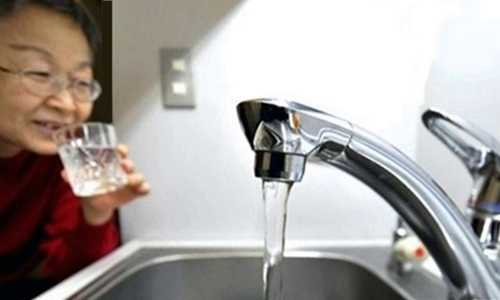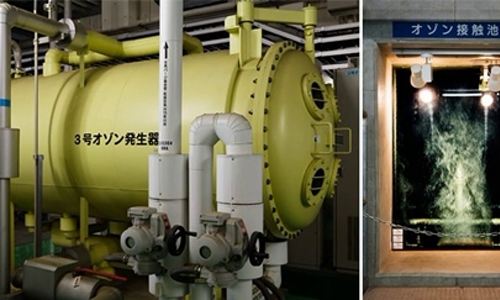Japan When you stay in Tokyo, you can see that the hotel has prepared several bottles of mineral water but instead of using them, you can drink them directly from the tap.
Before a drop of water reaches Japanese people, it must pass 51 stringent quality standards set by the Japanese Ministry of Health, Labor and Welfare, including toxicology, pollutants, along with tests to ensure color, clarity and odor. In fact, Japanese regulations on domestic water are more stringent than bottled spring water.

A woman drinks water from a tap in Japan Photo: AFP
What makes Tokyo's water quality even higher is the strict water treatment regime that includes about 200 safety and quality parameters.
Hashimoto Takashi, head of the Misono treatment plant in Itabashi, confidently said that he no longer needed bottled water. "Why should I do this when there is clean, safe water running right from the tap," he said.
Misono is one of five water treatment plants operated by the Tokyo Metropolitan Government Water Supply Department, with a daily treatment capacity of 300,000 m3, using standard processes along with advanced ozone treatment and bioactive carbon. According to Hashimoto, the advanced system eliminates nearly all dissolved organic matter that standard treatment systems cannot.
The ozone bath takes about 20 minutes to remove inorganic substances, including trihalomethane and other carcinogens, and microorganisms such as bacteria and protozoa, eliminating potential risks. health and ensure the taste of water.
The water then flows from the ozone chamber to the filter tank containing bioactive carbon. In addition to filtering organic pollutants like home water filters, micro-carbon also removes byproducts from ozone treatment. Failure to do so may reduce the taste of water.

Ozone machine at the Misono factory Photo: Nippon
The quality of the water determines the level of treatment. Tokyo gets 80% of its water from the Tonegawa and Arakawa rivers, 20% from the Tamagawa river. Hashimoto explained that the water from Tamagawa is so pure that it only needs standard processing steps to be able to drink. Meanwhile, the water quality from the other two rivers is lower. But by advanced water treatment, the system can deliver exceptionally high water quality.
The Tokyo Metropolitan Government Water Supply Bureau is constantly looking for ways to improve its operations. In addition to government standards, they set eight more quality standards to eliminate substances that could cause an unpleasant odor or taste. The two "culprits" are bacteria and chlorination.
Japanese law requires chlorination of drinking water to prevent the growth of bacteria and microorganisms. They defined excess chlorine levels in the range of 0.1 to 1 milligrams per liter at the time the water reaches people's homes. Tokyo has a stricter standard by setting a limit of excess of 0.1 to 0.4 milligrams per liter of chlorine to prevent people from feeling the taste of chlorine.
Hashimoto describes the challenge in achieving this goal: After the water leaves the treatment plant, the residual chlorine concentration decreases. However, temperature and other factors can affect this speed and it will take a lot of effort to ensure that the limits are met.
In some public places in Tokyo such as train stations or parks, bottled tap water is sold for around 100 yen for the purpose of promoting the city or used as a souvenir from Tokyo.



 MariaLouise
MariaLouise







